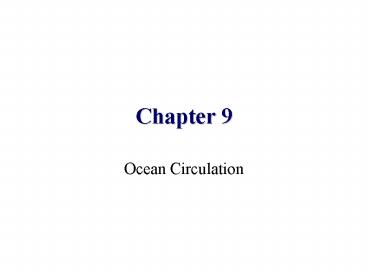Ocean Circulation PowerPoint PPT Presentation
Title: Ocean Circulation
1
Chapter 9
- Ocean Circulation
2
Types of Ocean Currents
- Surface currents
- Only involve 10 of the water in the ocean
- Thermohaline circulation
- Slow, deep water circulation driven by density
differences
3
Surface Currents
- Surface currents are driven by 3 factors
- Wind drag
- Pressure gradients
- Coriolis deflection
4
Wind Currents
- Friction caused by wind blowing across the ocean
pushes surface currents
5
- Surface currents move at a 45 angle to wind
direction - Net water transport is at a right angle to wind
direction
6
Pressure Gradients
- The net transport of water causes it to pile up
in a hill in the middle of the ocean - Gravity pulls the water down the hill
- The location of the hill is to the left of center
because of earths rotation
7
- Because of atmospheric circulation patterns,
there is a high pressure area in the center of
the large ocean currents - This also causes the water to mound up in the
middle
8
Coriolis Deflection
- Currents in the northern hemisphere rotate in a
clockwise direction - Currents in the southern hemisphere rotate in a
counter-clockwise direction
9
- These large currents are called geostrophic gyres
10
Eastern vs. Western Currents
- Western currents
- Narrow
- Fast
- Deep
Eastern currents Wide Slow Shallow
11
Eastern vs. Western Currents
- Western currents
- Warm
- Low productivity
- Eastern currents
- Cold
- High productivity
12
Other currents
- Transverse currents
- The northern and southern portions of the gyres
- Equatorial currents stronger than high latitude
currents - West wind drift (Antarctic circumpolar current)
- Largest of all surface currents, caused by strong
Antarctic west wind - Never deflected by a continent
13
Countercurrents and Undercurrents
- Countercurrents
- Currents flowing in the opposite direction of the
main current - Backward flow is because of the lack of wind, and
pile-up of water on the western edge of the ocean
basin - Undercurrents
- Countercurrents that flow under surface currents
- Can be very large (as big as the current above
sometimes)
14
Effects on Climate
- Cold ocean currents (eastern currents) usually
cause cooler, dryer weather - The cool water doesnt have enough heat in it for
much water to evaporate out of it, so the air is
dry - Warm ocean currents (western currents) usually
cause warmer, more humid weather - The warm water causes a lot of evaporation, so
the air is humid - Therefore, on most continents, the western coast
is dryer than the eastern coast
15
Upwelling and Downwelling
- If wind is blowing parallel to shore, the water
will move 90 to the right - If this moves water away from the coastline,
upwelling will occur - This happens with a northerly wind on the west
coast - If this moves water towards the coastline,
downwelling will occur - This happens with a southerly wind on the west
coast
16
- Upwelling also occurs along the equator
- Because surface water is removed by the
geostrophic gyres and surface winds - Upwelling and downwelling can occur at high
latitudes - Because there is no pycnocline
17
El Niño/La Niña
- Under normal circumstances, there is a cold water
current flowing from east to west at the equator - During an El Niño year, the currents are backed
up, and the equatorial current becomes warmer
than usual
18
- El Nino can seriously impact marine life off of
the west coast of the Americas because of the
lack of nutrients in the warmer water - Normally arid regions on the west coast of the
Americas receive higher than usual rain
19
Thermohaline Circulation
- Caused by density differences (salinity and
temperature)
20
(No Transcript)
21
(No Transcript)
22
(No Transcript)

